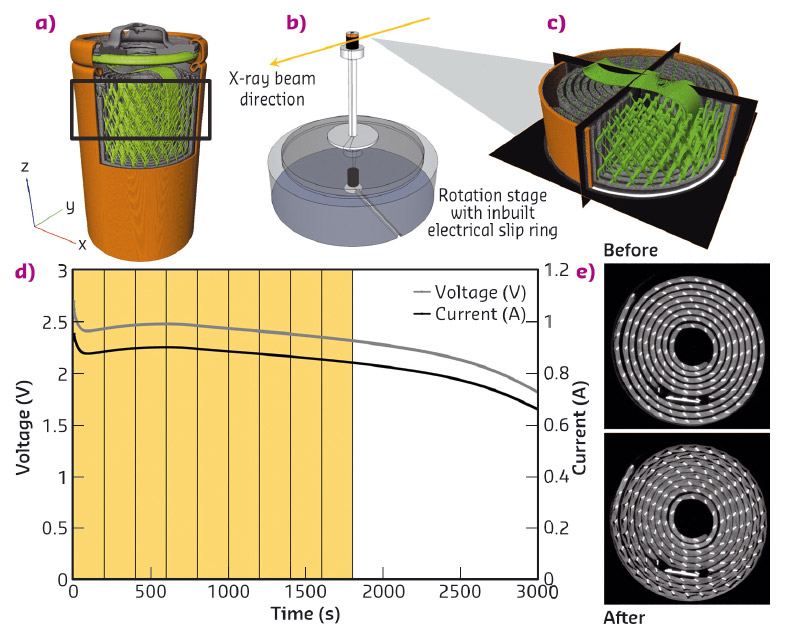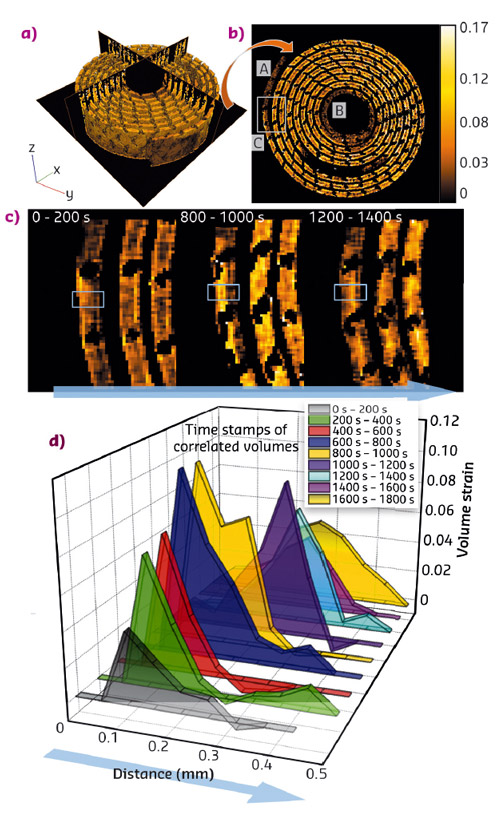- Home
- Users & Science
- Scientific Documentation
- ESRF Highlights
- ESRF Highlights 2016
- Structure of materials
- Tracking the evolving architecture of active materials within lithium batteries
Tracking the evolving architecture of active materials within lithium batteries
High-speed operando X-ray computed tomography (CT) was used to capture the morphological evolution of active materials within a primary Li/MnO2 battery during discharge. The local displacement of materials within the battery was quantified in 3D by correlating sequential tomograms using digital volume correlation (DVC), revealing degradation mechanisms and causes of performance loss.
Owing to their high energy and power density, lithium batteries are the technology of choice for applications that require compact, reliable, and high-performance energy-storage devices, such as emergency signal transmitters, and other systems in the aerospace, military and communications sectors. Understanding the causes of performance loss such as degradation mechanisms that occur during operation is a significant step towards engineering batteries with improved performance, reliability and safety. However, the degradation that stems from the dynamic changes to the internal architecture of a cell during operation remains poorly understood.
Volumetric expansion of the positive electrode occurs when lithium inserts into electrode materials (lithiation). The chemo-mechanical forces associated with lithiation can cause significant degradation, for example causing electrical isolation of the electrode from the current collector or particle cracking. Characterising the local dilation and displacement of electrode material during operation would help progress towards designing cells that cater for dynamic structural evolution, and mitigate degradation and performance loss.
 |
|
Fig. 65: a) Full Duracell CR2 battery. b) ID15A rotation stage with in-built electrical slip-ring for operando X-ray CT. c) Volume that was imaged during operando CT showing current collector (green) and MnO2 electrode (grey). d) Discharge profile marking lapsed time between sequential tomograms used for DVC. e) XY slices from tomograms taken before and after discharge (excluding cell casing), showing the damaged MnO2 electrode. |
The high-speed X-ray CT imaging capabilities of the ESRF present a great opportunity for non-destructive imaging of morphological evolution of active materials during cell operation. Operando X-ray CT has been demonstrated as a powerful diagnostic tool for battery degradation [1]. Image correlation techniques such as digital volume correlation (DVC), that quantify the displacement of features between consecutive tomograms, greatly complement the high acquisition rates of synchrotrons, presenting scope for performing 4D (3D with time) strain profiling of deforming materials; this has been shown to be particularly useful for identifying limitations of lithium ion batteries [2]. Here, we capture the morphological evolution of the spiral-wound electrode architecture of a commercial Li/MnO2 Duracell CR2 cell during a high-rate discharge (Figure 65). The high photon flux of beamline ID15A allowed fast acquisition of tomograms (Figure 65c) at various stages during discharge of the cell (Figure 65d).
Severe delamination of the MnO2 electrode material from the current collector started to develop at early stages of the discharge process, increasing the electrical resistance of the cell and significantly affecting its performance. To gain insight into the cause of delamination, consecutive tomograms were correlated using DVC to quantify the local displacement of electrode material over time. 3D strain maps that show the transient local displacement of the electrode during operation (Figure 66a,b) were generated. A significant portion of the MnO2 electrode was shown to be inactive, particularly at the ends of the spiral wound layer (regions A and B in Figure 66b). Using DVC, the progression of lithiation through the MnO2 layer was tracked; a displacement front that is representative of the dilation and hence lithiation of the MnO2 is observed (Figure 66c,d), highlighting that the cell is limited by ion transport.
 |
|
Fig. 66: a) Reconstruction of volumetric strain. b) XY slice from DVC of sequential tomograms during discharge. Regions A and B show areas where electrode material is inactive and C highlights where lithiation occurs from one side only. c) Magnified views of region C showing evolving volumetric strain profile with boxed (blue) regions of interest. d) Evolution of strain measured across the boxed regions in (c). |
Furthermore, the chemo-mechanical effect of the dilating electrode on the mechanical environment of the cell is revealed. As well as highlighting the importance of the design of lithium batteries to accommodate changing cell architectures, this study has also demonstrated the combination of high-speed operando X-ray CT and image correlation techniques as an effective means to identify degradation and causes of performance loss within operating cells.
Principal publication and authors
Quantifying bulk electrode strain and material displacement within lithium batteries via high-speed operando tomography and digital volume correlation, D.P. Finegan (a), E. Tudisco (b), M. Scheel (c,d), J.B Robinson (a), O.O Taiwo (a), D.S. Eastwood (e,f), P.D. Lee (e,f), M. Di Michiel (c), B. Bay (g), S.A. Hall (b), G. Hinds (h), D.J.L. Brett (a) and P.R. Shearing (a), Adv. Sci. 3, 1500332 (2016); doi: 10.1002/advs.201500332.
(a) Electrochemical Innovation Lab, Department of Chemical Engineering, University College London (UK)
(b) Division of Solid Mechanics, Lund University (Sweden)
(c) ESRF
(d) Synchrotron Soleil, Gif-sur-Yvette (France)
(e) Manchester X-ray Imaging Facility, School of Materials, University of Manchester (UK)
(f) Research Complex at Harwell, Didcot (UK)
(g) School of Mechanical Industrial and Manufacturing Engineering, Oregon State University (USA)
(h) National Physical Laboratory, Teddington (UK)
References
[1] M. Ebner et al., Science 342, 716-720 (2013).
[2] D.S. Eastwood et al., Advanced Energy Materials 4, 57 (2014).



